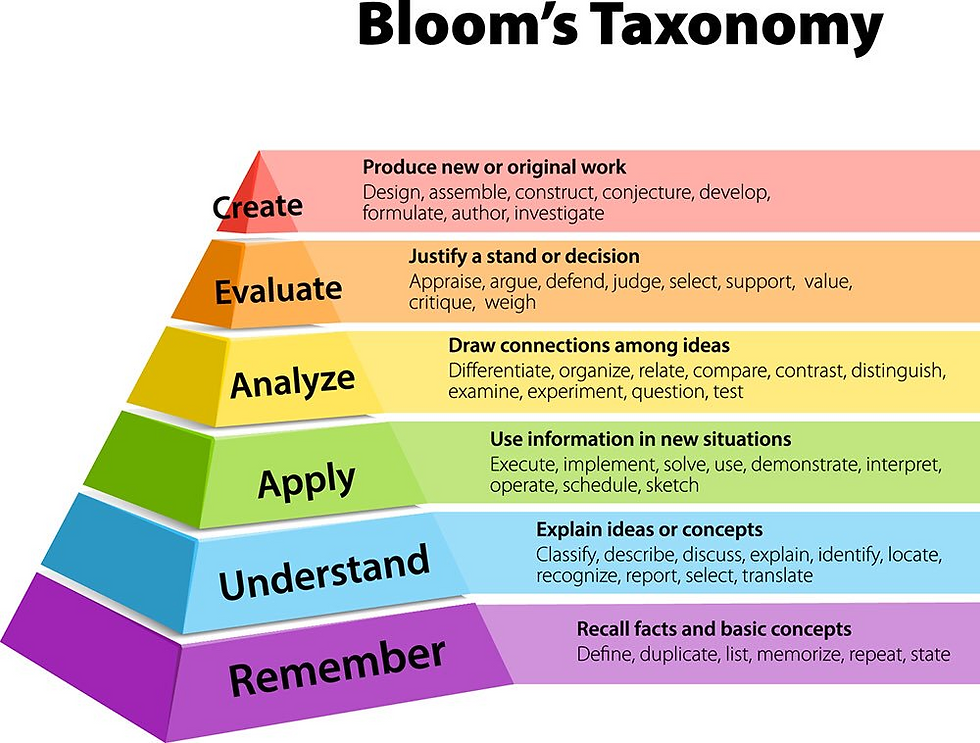Unlocking Potential: How Teachers Can Use Bloom's Taxonomy Technique to Boost Classroom Productivity
- Anuradha Das
- Apr 23, 2023
- 2 min read
In today's fast-paced educational environment, teachers are always looking for methods to maximise their productivity and classroom time. Bloom's Taxonomy is a potent technique that not only assists educators in developing diverse learning experiences, but also saves time and increases productivity. In this blog post, we will examine the fundamentals of Bloom's Taxonomy, its benefits, and how to implement it effectively in the classroom. So, let's plunge in!
Understanding Bloom's Taxonomy
Bloom's Taxonomy is a hierarchical classification of cognitive skills designed to assist educators in designing educational objectives and evaluating students' subject comprehension. The taxonomy has six levels: remembering, comprehending, applying, analysing, and evaluating, and creating. By addressing these various cognitive levels, teachers can create a well-rounded, engaging learning environment that meets the diverse requirements of their students.
Advantages of Bloom's Taxonomy: Implementing Bloom's Taxonomy in the classroom provides teachers and pupils with numerous benefits. Some important benefits include:
Developing higher-order cognitive abilities
Developing abilities in critical reasoning and problem-solving
Ensuring a comprehensive comprehension of the subject
Providing a transparent structure for lesson planning and evaluation
Facilitating differentiated instruction to meet the varied educational requirements
Using Bloom's Taxonomy to Design Lessons:
Begin the incorporation of Bloom's Taxonomy into your lesson planning by establishing clear and specific learning objectives for each cognitive level. For instance:
Students will recall the primary causes of World War II.
Students will explain the impact of World War II on international politics.
Students will use a historical map to determine which nations participated in World War II.
As you organise your lessons, make sure that your activities and assessments target each of these cognitive levels, allowing students to advance through the taxonomy as their understanding of the topic deepens.
Bloom's Taxonomy provides a plethora of ideas for devising challenging and engaging classroom activities. Here are several illustrations for each cognitive level:
Conduct a trivia contest or utilise flashcards to reinforce key concepts.
Encourage group discussions or debates that investigate contrasting viewpoints.
Design hands-on activities or experiments to assist students in applying their knowledge in a practical setting.
Assign case studies or research assignments to students to hone their analytical skills.
Organize a peer review session or ask students to evaluate a piece of work when evaluating.
Inspire creativity with open-ended initiatives, such as the design of a new product or the creation of an artwork.
Assessing Student Progress: Bloom's Taxonomy is a useful guide for developing assessments that accurately measure students' knowledge and abilities. By designing assessments that target each cognitive level, you can obtain a more comprehensive view of students' progress and identify areas in which they may require additional assistance.
Bloom's Taxonomy is a powerful instrument for educators seeking to save time, boost productivity, and develop diverse learning environments. Teachers can foster higher-order thinking skills, engage students in meaningful learning activities, and ultimately unlock their students' maximum potential by implementing this technique in the classroom.

Comments